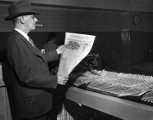American Union
Place of publication: Martinsburg, VA [W. Va.]
Around ten o'clock in the evening on July 3, 1861, a dozen soldiers of the Union army entered the offices of the Virginia Republican --a decidedly secessionist organ--and appropriated the newspaper's office to their own use. The next day, the Fourth of July, the first issue of the American Union hit the streets of Martinsburg, Virginia (now West Virginia). Run entirely by Union soldiers who had volunteered for the project, the American Union enjoyed a brief existence in Martinsburg, providing U.S. forces with a source of news and patriotic rhetoric while serving on enemy soil.
The early summer of 1861 witnessed an America torn apart by the seams as the Southern states seceded and war loomed on the horizon. Armies of green troops, both Northern and Southern, were mustered and marched around the nation, and in western Virginia thousands of Union volunteers organized under the command of Major General Robert Patterson. Meant to occupy the attention of Confederate troops in the Shenandoah Valley, Patterson's men secured western Maryland and occupied Martinsburg, Virginia.
Among this body of blue-clad troops marched Captain William B. Sipes of the 2nd Pennsylvania Infantry Regiment. Before the war, William Sipes served as the editor for the Pottsville [Pennsylvania] Register, a Democratic newspaper. Upon war's outbreak, Sipes joined the 2nd Pennsylvania, a regiment whose three-month term of service reflected the widespread belief that the war would prove short and victorious. Despite the captain's bars on his shoulders, however, William Sipes soon found himself in a familiar position as editor of the American Union.
The American Union offered soldiers a glimpse into the wider world, and particularly the military situation. Announcements from high command, provost guard updates, reports of nearby skirmishes and more allowed soldiers to gain a broader picture of the war around them. Moreover, the Union provided soldiers with a source of entertainment, as each issue contained a variety of songs and poems, often lauding Northern manliness or ridiculing the Southern war effort. "The Star-Spangled Banner" and the Declaration of Independence also made appearances in the Union.
The American Union, however, did not view Union soldiers at its sole audience. Each issues of the Union also contained addresses "To the People of Virginia," which attempted to assuage the anxiety of Virginians and assure them that the blue-clad soldiers came as friends, not enemies. Arguing that the reasons for war had been "grossly misrepresented to you," the Union asserted that Federal forces only meant to " reestablish peace and order" and uphold the Constitution. Hoping to end the South's "unholy revolution," the workers of the Union looked forward "to the time when the American Union will be reconstructed in all its grandeur and power."
The American Union lasted only a week. Undoubtedly, this is due to the movement of General Patterson's forces, and the loss of the Virginia Republican's facilities with which to produce the Union. Still, it is impressive that a handful of soldiers were able to produce six issues of the paper while still shouldering their martial responsibilities. Moreover, the Union offers a window into Union soldiers perceptions early in the war--their belief in the righteousness of their cause, the patriotism extolled in every song and poem, and the importance of sharing their views with one another.
Provided by: West Virginia University


